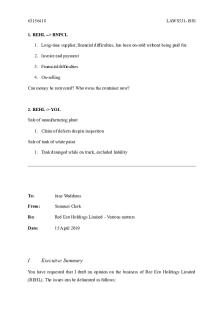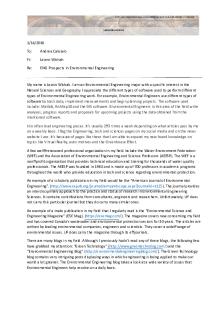MGT495-Memo3-final - Final Memo 3. Mandatory assignment. Professor Sanchez. PDF

| Title | MGT495-Memo3-final - Final Memo 3. Mandatory assignment. Professor Sanchez. |
|---|---|
| Course | Administrative Policy |
| Institution | Grand Valley State University |
| Pages | 3 |
| File Size | 106.5 KB |
| File Type | |
| Total Downloads | 57 |
| Total Views | 135 |
Summary
Mandatory assignment - memo 3. Professor Sanchez. ...
Description
MEMORANDUM To: Re:
Dr. Carlos M. Smith Business, Corporate, and Innovation-Level Analysis of Herman Miller
Summary Herman Miller has been successful in their efforts to provide innovative solutions to the office furniture industry, classified under the NAICS code 337214. The firm utilizes a focused differentiated businesslevel strategy to implement new ergonomic technologies which have effectively set their products apart from their industry competitors. This industry approach is supported by the development of a corporatelevel positioning strategy that utilizes a concentrated approach to maximize their market penetration through unique product development at every level of the organizations structure. By recognizing the value added to their products through way of maximizing their research and development capabilities and efficiencies, Herman Miller has established a competitive advantage through offering ergonomically advanced office furniture products. Industry Analysis and Financial Examination The industry shows high barriers to new entrants who are challenged with high levels of capital investment to participate in the industry. The industry demonstrates low threats of substitution due to lack of substitutability for furniture. The buyer power of the industry is strong due to intensive capital requirements associated with consumers’ decisions to switch products being discouraged by the high price of products that offer similar features. Since product offerings seek to fulfill similar requirements, producers diversify their market approach by occupying a differentiated business model to appeal to a wide range of customers. Supplier power in the furniture manufacturing industry is isolated to raw material manufacturers who possess low levels of control due to the similarities in the nature of the products offered; instead, suppliers compete within the market by providing effective client relations, fast delivery, and competitive pricing. This low level of supplier power is attractive to buyers who are able to switch between suppliers easily in pursuit of low costs and satisfactory quality. Overall, the furniture manufacturing industry isolates high levels of competitive rivalry for buyers and suppliers. Buyers engage in competitive rivalry within the market as a result of the similarity of their product offerings and target clientele. These aspects motivate manufacturers to differentiate their offerings on the basis of price and innovation while suppliers engage in competitive rivalry through the similarities of buyer expectations. Considering the nature of competitive rivalry within the industry, Herman Miller is able to distinguish their offerings by emphasizing the value in their ergonomically superior product offerings. This resource serves as a competitive advantage because effective innovation sets apart the firm’s products in a market with similar offerings. Evaluating the organization’s financial position in reference to the industry average, it becomes apparent that Herman Miller maintains profits that exceed the industry average along with more efficient inventory and asset turnover ratios. Herman Miller’s above average operating cash flow ratio and highly levered capital structure also provides insight towards their corporate strategy of developing the most advanced furniture solutions. These financial outputs provide evidence that pursuing innovation has proven to be an effective strategy for the organization based on the positive returns they have seen in response to capital expenditures and new project development activities. Herman Miller’s Business-Level Strategy Reaffirms their Value Chain Proposition Applying our understanding of Herman Miller’s value proposition of providing products that embody “creative direction and new product commercialization to foster innovation, elevate design execution, and increase speed to market.” (Walker, 2017), we are able to increase our understanding of the organizations efforts to add value through their business-level positioning strategies. This approach is facilitated by the organization’s infrastructure, where key executives such as the CEO, Brian Walker, emphasize the value added through the development of a focused differentiated strategy which offers unique products that
justify the higher than average costs associated with their products. This strategy is reaffirmed by the organizations human resource management rationale which values the impact of increased research and development staffing and spending to create products that align with their focused differentiated businesslevel strategy. Herman Miller has cited a three-year historic R&D intensity of 2.6%, 42% higher than the industry average of 1.5%, which illustrates their priority towards technological development as a means to provide differentiated alternatives to the office furniture industry. The business-level approach continues to facilitate the qualities of a focused differentiated approach through their efforts to engage in mergers and acquisitions which enables the organization to carry out advanced product research and development without engaging in external business activities. The Corporate-Level Strategy Extends the Values Prioritized at the Business-Level Herman Miller’s business-level strategies and value chain position isolates their continuous efforts to implement innovative alternatives to set themselves apart from their competitors in the high-end office furniture industry. This approach acknowledges the value added to their operations by increasing capital spending for research and development as a means to create ergonomically advanced products that facilitate increased productivity and sustainable performance for the users of their products. This business-level strategy is reaffirmed by the organizations corporate-level strategy which facilitates a high level of innovation to provide dominant product solutions in comparison to competitor offerings. This positioning strategy is facilitated by Herman Miller’s decisions to engage in vertical integration through mergers and acquisitions which allow the firm to centralize their research and development activities. This statement is reaffirmed by Walker’s efforts to “combine the functions of Strategy, Mergers and Acquisitions, Channel Development, and Information Technology to drive the integration of acquired companies, expand channels to market, and develop new technological capabilities.” This statement isolates their efforts to continue applying an innovative approach while developing the capability further by increasing the efficiency of the process. Using this approach, Herman Miller is able to utilize a concentration strategy which prioritizes their ergonomically advanced office furniture solutions to increase their market penetration within their current industry through superior product development. How can the Organization Continue to Prioritize their Innovative Edge? While the firm has effectively recognized a strong correlation between research and development intensity and industry success within the office furniture segment, they have not demonstrated any intention to employ this competency in the home furniture industry which demonstrates similar production processes and equipment requirements. This isolates opportunities for Herman Miller to utilize their existing infrastructure and resource to occupy a new market with similar characteristics to their current industry segment. Expanding the firm’s product offerings into new markets poses execution risk internally, where they are forced to isolate aspects of home furniture products that align with their innovative capability to provide opportunities for developing unique products. The success of their horizontal expansion into the home furniture market could also pose challenges for Herman Miller through their development of new suppliers. If the suppliers are unable to meet the demands of the firm’s new product concepts, co-innovation risk could be a determining factor contributing to unsuccessful adaptation of the new segment. If Herman Miller is able to develop and manufacture unique product offerings for the home furniture industry, they will also need to consider the adoption chain risk associated with establishing distribution centers for their new product as well as educating consumers towards their entrance into the industry. Overall, Herman Miller possesses the core competencies necessary to expand their product offerings beyond the office setting, however the differences in suppliers, distributors, and the product requirements of the home furniture setting could pose challenges that would limit the success of their expansion.
References
Raheja, N. (2013, June 19). Herman Miller's Competitive Advantage: Innovation. Retrieved October 7, 19AD, from https://seekingalpha.com/article/1510792-herman-millerscompetitive-advantage-innovation. Birchard, B. (2010, May 25). Herman Miller's Design for Growth. Retrieved October 7, 2019, from https://www.strategy-business.com/article/10206?gko=5ae0d. Budds, D. (2018, August 24). How America's Most Iconic Design Brand Is Planning Its Next Century. Retrieved October 7, 2019, from https://www.fastcompany.com/3059416/howamericas-most-iconic-design-brand-is-planning-its-next-century. Yohn, D. L. (2018, September 6). herman miller, a business lab disguised as a furniture company. Retrieved from https://deniseleeyohn.com/herman-miller-a-business-lab-disguised-as-afurniture-company/. Lin, M. (2014, January 27). Why Size and Branding Aren't Advantages for Office-Furniture Manufacturers. Retrieved October 7, 2019, from https://www.fool.com/investing/general/2014/01/27/why-size-and-branding-arentadvantages-for-office.aspx. Walker, B. (2017, February 6). Herman Miller Realigns Organizational Structure to Accelerate Strategic Execution. Retrieved November 5, 2019, from https://www.hermanmiller.com/press/pressreleases/herman-miller-realigns-organizational-structure-to-accelerate-strategic-execution/. Young, J. (2019, March 3). West Michigan manufacturers increase R&D spending. Retrieved November 5, 2019, from https://mibiz.com/sections/manufacturing/west-michigan-manufacturers-increase-rd-spending....
Similar Free PDFs

Project-3 - mandatory assignment
- 12 Pages

Memo - Business Memo Assignment
- 2 Pages

Assignment MANDATORY
- 3 Pages

assignment mandatory
- 38 Pages

Memo assignment
- 10 Pages

Final memo
- 2 Pages

Memo 1 - Memo 1 Assignment
- 2 Pages

Memo to Professor from Interview
- 1 Pages

MCAT Physics - Mandatory Assignment
- 15 Pages

Essay 2 - Mandatory Assignment
- 5 Pages

BILL 168 - Mandatory Assignment
- 2 Pages

TWC Assignment Memo 2 and Memo 4
- 4 Pages
Popular Institutions
- Tinajero National High School - Annex
- Politeknik Caltex Riau
- Yokohama City University
- SGT University
- University of Al-Qadisiyah
- Divine Word College of Vigan
- Techniek College Rotterdam
- Universidade de Santiago
- Universiti Teknologi MARA Cawangan Johor Kampus Pasir Gudang
- Poltekkes Kemenkes Yogyakarta
- Baguio City National High School
- Colegio san marcos
- preparatoria uno
- Centro de Bachillerato Tecnológico Industrial y de Servicios No. 107
- Dalian Maritime University
- Quang Trung Secondary School
- Colegio Tecnológico en Informática
- Corporación Regional de Educación Superior
- Grupo CEDVA
- Dar Al Uloom University
- Centro de Estudios Preuniversitarios de la Universidad Nacional de Ingeniería
- 上智大学
- Aakash International School, Nuna Majara
- San Felipe Neri Catholic School
- Kang Chiao International School - New Taipei City
- Misamis Occidental National High School
- Institución Educativa Escuela Normal Juan Ladrilleros
- Kolehiyo ng Pantukan
- Batanes State College
- Instituto Continental
- Sekolah Menengah Kejuruan Kesehatan Kaltara (Tarakan)
- Colegio de La Inmaculada Concepcion - Cebu



